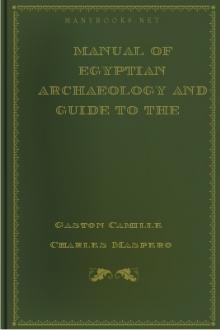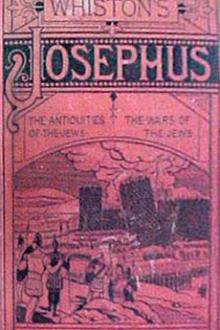Manual of Egyptian Archaeology and Guide to the Study of Antiquities in Egypt by Gaston Maspero (i have read the book txt) 📕

107. Wall-scene from temple of Denderah
108. Obelisk of Heliopolis, Twelfth Dynasty
109. Obelisk of Begig, Twelfth Dynasty
110. "Table of offerings" from Karnak
111. Limestone altar from Menshîyeh
112. Wooden naos, in Turin Museum
113. A mastaba
114. False door in mastaba
115. Plan of forecourt, mastaba of Kaäpir
116. Plan of forecourt, mastaba of Neferhotep
117. Door in mastaba façade
118. Portico and door of mastaba
119. Plan of chapel, mastaba of Khabiûsokari
120. Plan of chapel, mastaba of Ti
121. Plan of chapel, mastaba of Shepsesptah
122. Plan of chapel, mastaba of Affi
123. Plan of chapel, mastaba of Thenti
124. Plan of chapel, mastaba of Red Scribe
125. Plan of chapel, mastaba of Ptahhotep
126. Stela in mastaba of Merrûka
127. Wall-scene from mastaba of Ptahhotep
128. Wall-scene from mastaba of Ûrkhûû
129. Wall-scene from mastaba of Ptahhotep
130. Plan of serdab in mastaba at Gizeh
131. Plan of serdab and
Read free book «Manual of Egyptian Archaeology and Guide to the Study of Antiquities in Egypt by Gaston Maspero (i have read the book txt) 📕» - read online or download for free at americanlibrarybooks.com
- Author: Gaston Maspero
- Performer: -
Read book online «Manual of Egyptian Archaeology and Guide to the Study of Antiquities in Egypt by Gaston Maspero (i have read the book txt) 📕». Author - Gaston Maspero
Most of the plaques represent only rosettes, stars, and single flowers or posies. One of the smallest represents a black-and-white Apis walking, the work being so delicate that it loses none of its effect under the magnifying glass. The greater number of these objects date from, and after, the first Saïte dynasty; but excavations in Thebes and Tell el Amarna have proved that the manufacture of coloured glass prevailed in Egypt earlier than the tenth century before our era. Fig 226.--Parti-coloured glass vase. Fig 226.--Parti-coloured glass vase.
At Kûrnet Murraee and Sheikh Abd el Gûrneh, there have been found, not only amulets for the use of the dead, such as colonnettes, hearts, mystic eyes, hippopotami walking erect, and ducks in pairs, done in parti-coloured pastes, blue, red, and yellow, but also vases of a type which we have been accustomed to regard as of Phoenician and Cypriote manufacture.[60] Here, for example, is a little aenochoe, of a light blue semi-opaque glass (fig. 225); the inscription in the name of Thothmes III., the ovals on the neck, and the palm-fronds on the body of the vase being in yellow. Here again is a lenticular phial, three and a quarter inches in height (fig. 226), the ground colour of a deep ocean blue, admirably pure and intense, upon which a fern-leaf pattern in yellow stands out both boldly and delicately. Fig 227.--Parti-coloured glass vase. Fig 227.--Parti-coloured glass vase.
A yellow thread runs round the rim, and two little handles of light green are attached to the neck. A miniature amphora of the same height (fig. 227) is of a dark, semi-transparent olive green. A zone of blue and yellow zigzags, bounded above and below by yellow bands, encircles the body of the vase at the part of its largest circumference. The handles are pale green, and the thread round the lip is pale blue. Princess Nesikhonsû had beside her, in the vault at Deir el Baharî, some glass goblets of similar work. Seven were in whole colours, light green and blue; four were of black glass spotted with white; one only was decorated with many-coloured fronds arranged in two rows (fig. 228). The national glass works were therefore in full operation during the time of the great Theban dynasties. Huge piles of scoriae mixed with slag yet mark the spot where their furnaces were stationed at Tell el Amarna, the Ramesseum, at El Kab, and at the Tell of Eshmûneyn.
The Egyptians also enamelled stone. One half at least of the scarabaei, cylinders, and amulets contained in our museums are of limestone or schist, covered with a coloured glaze. Doubtless the common clay seemed to them inappropriate to this kind of decoration, for they substituted in its place various sorts of earth--some white and sandy; another sort brown and fine, which they obtained by the pulverisation of a particular kind of limestone found in the neighbourhood of Keneh, Luxor, and Asûan; and a third sort, reddish in tone, and mixed with powdered sandstone and brick-dust. These various substances are known by the equally inexact names of Egyptian porcelain and Egyptian faïence. The oldest specimens, which are hardly glazed at all, are coated with an excessively thin slip. This vitreous matter has, however, generally settled into the hollows of the hieroglyphs or figures, where its lustre stands out in strong contrast with the dead surface of the surrounding parts. The colour most frequently in use under the ancient dynasties was green; but yellow, red, brown, violet, and blue were not disdained.[61] Blue predominated in the Theban factories from the earliest beginning of the Middle Empire. This blue was brilliant, yet tender, in imitation of turquoise or lapis lazuli. The Gizeh Museum formerly contained three hippopotamuses of this shade, discovered in the tomb of an Entef[62] at Drah Abû'l Neggeh[63] One was lying down, the two others were standing in the marshes, their bodies being covered by the potter with pen-and-ink sketches of reeds and lotus plants, amid which hover birds and butterflies (fig. 229). This was his naïve way of depicting the animal amid his natural surroundings. The blue is splendid, and we must overleap twenty centuries before we again find so pure a colour among the funerary statuettes of Deir el Baharî. Fig 229.--Hippopotamus in blue glaze. Fig 229.--Hippopotamus in blue glaze.
Green reappears under the Saïte dynasties, but paler than that of more ancient times, and it prevailed in the north of Egypt, at Memphis, Bubastis, and Sais, without entirely banishing the blue. The other colours before mentioned were in current use for not more than four or five centuries; that is to say, from the time of Ahmes I. to the time of the Ramessides. It was then, and only then, that ûshabtiû of white or red glaze, rosettes and lotus flowers in yellow, red, and violet, and parti-coloured kohl-pots abounded. The potters of the time of Amenhotep III. affected greys and violets. The olive-shaped amulets which are inscribed with the names of this Pharaoh and the princesses of his family are decorated with pale blue hieroglyphs upon a delicate mauve ground. The vase of Queen Tii in the Gizeh collection is of grey and blue, with ornaments in two colours round the neck. Fig 230.--Glazed ware from Thebes. Fig 230.--Glazed ware from Thebes.
The fabrication of many-coloured enamels seems to have attained its greatest development under Khûenaten; at all events, it was at Tell el Amarna that I found the brightest and most delicately fashioned specimens, such as yellow, green, and violet rings, blue and white fleurettes, fish, lutes, figs, and bunches of grapes.[64] One little statuette of Horus has a red face and a blue body; a ring bezel bears the name of a king in violet upon a ground of light blue. However restricted the space, the various colours are laid in with so sure a hand that they never run one into the other, but stand out separately and vividly. Fig 231.--Glazed ware from Thebes. Fig 231.--Glazed ware from Thebes.
A vase to contain antimony powder, chased and mounted on a pierced stand, is glazed with reddish brown (fig. 230). Another, in the shape of a mitred hawk, is blue picked out with black spots. It belonged of old to Ahmes I. A third, hollowed out of the body of an energetic little hedgehog, is of a changeable green (fig. 231). A Pharaoh's head in dead blue wears a klaft[65] with dark-blue stripes. Fine as these pieces are, the chef- d'oeuvre of the series is a statuette of one Ptahmes, first Prophet of Amen, now in the Gizeh Museum. Fig 232. Fig 232.
Fig 233.--Interior decoration of cup, Eighteenth Dynasty. Fig 233.--Interior decoration of cup, Eighteenth Dynasty.
The hieroglyphic inscriptions as well as the details of the mummy bandages are chased in relief upon a white ground of admirable smoothness afterwards filled in with enamel. The face and hands are of turquoise blue; the head- dress is yellow, with violet stripes; the hieroglyphic characters of the inscription, and the vulture with outspread wings upon the breast of the figure, are also violet. The whole is delicate, brilliant, and harmonious; not a flaw mars the purity of the contours or the clearness of the lines.
Glazed pottery was common from the earliest times. Cups with a foot (fig. 232), blue bowls, rounded at the bottom and decorated in black ink with mystic eyes, lotus flowers, fishes (fig. 233), and palm-leaves, date, as a rule, from the Eighteenth, Nineteenth, or Twentieth Dynasties. Lenticular ampullae coated with a greenish glaze, flanked by two crouching monkeys for handles, decorated along the edge with pearl or egg-shaped ornaments, and round the body with elaborate collars (fig. 234), belong almost without exception to the reigns of Apries and Amasis.[66] Sistrum handles, saucers, drinking-cups in the form of a half-blown lotus, plates, dishes--in short, all vessels in common use--were required to be not only easy to keep clean, but pleasant to look upon. Did they carry their taste for enamelled ware so





Comments (0)